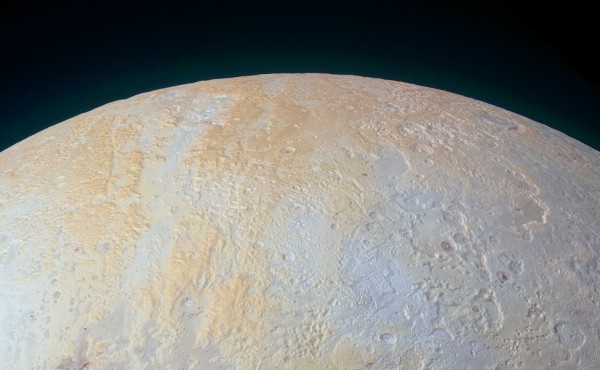By Ana Verayo, | February 27, 2016

NASA's New Horizons captured Pluto's north pole last July 14.
After its epic flyby last July, dwarf planet Pluto is now revealing its true faces and colors as a new image was released taken by NASA's New Horizons spacecraft that continues to surprise scientists.
This new image from the New Horizons probe reveals the majestic icy canyons of Pluto's northern polar region or its north pole. The long canyons are viewed running vertically across the frozen region which is also known as the Lowell Region. The region is named after Percival Lowell who is the founder of Lowell Observatory, who also led the search for Pluto.
Like Us on Facebook
The widest and most distinct of the canyons are estimated to be 45 miles wide that closely traverse through the north pole. There are subsidiary canyons that roughly run parallel in the eastern and western regions that are almost six miles wide. There are also other canyons that pockmark Pluto however these icy canyons possess more distinct, disintegrating walls that appears more ancient than the others, providing evidence of the planet's geological activity.
Apart from these canyons, there is also a rather shallow, winding valley that is running the entire length of the canyon floor that possess pits that are irregularly shaped, measuring 45 miles across and reaching 2.5 miles deep into the interior. Scientists also believe that there are subsurface ice formations that already melted below, causing the collapsing of the ground, ultimately forming these pits.
Mission scientists also note the unusual color of this region as higher elevations are shown in a distinct yellow hue that has not been observed in the other parts of the dwarf planet. As this yellowish terrain fades into a bluish grey, these darker regions indicate lower elevations and latitudes that matches with New Horizons infrared measurements, revealing the presence of abundant methane ice across the Lower Regio.
According to New Horizons lead scientist Will Grundy from Lowell Observatory, the possible explanation to this yellow terrain can be linked to older methane deposits that have undergone solar radiation processing compared to the blue terrain.
This image was take from a distance of 21,000 miles from Pluto, some 45 minutes before New Horizons made its closest approach to the planet on its first flyby last July 14.
-
Use of Coronavirus Pandemic Drones Raises Privacy Concerns: Drones Spread Fear, Local Officials Say

-
Coronavirus Hampers The Delivery Of Lockheed Martin F-35 Stealth Fighters For 2020

-
Instagram Speeds Up Plans to Add Account Memorialization Feature Due to COVID-19 Deaths

-
NASA: Perseverance Plans to Bring 'Mars Rock' to Earth in 2031

-
600 Dead And 3,000 In The Hospital as Iranians Believed Drinking High-Concentrations of Alcohol Can Cure The Coronavirus

-
600 Dead And 3,000 In The Hospital as Iranians Believed Drinking High-Concentrations of Alcohol Can Cure The Coronavirus

-
COVID-19: Doctors, Nurses Use Virtual Reality to Learn New Skills in Treating Coronavirus Patients







